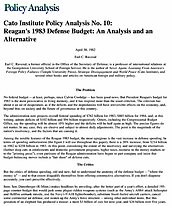No federal budget — at least, perhaps, since Calvin Coolidge — has been good news. But President Reagan’s budget for 1983 is the most provocative in living memory, and it has inspired more than the usual criticism. The criticism has about it an air of desperation, as if the deficits and the depredations will have irreversible effects on the economy, and, beyond that, on society and the future of governance in this country.
The administration now projects overall federal spending of $762 billion for 1983, $803 billion for 1984, and, at this writing, admits deficits of $102 billion and $94 billion respectively. Others, including the Congressional Budget Office, say the spending will be almost 10% higher and the deficits will be half again as high. The precise figures do not matter. In any case, they are elusive and subject to almost daily adjustments. The point is the magnitude of the nation’s insolvency, and the factors that are causing it.
Among the notable features of the Reagan 1983 budget, the most egregious is the vast increase in defense spending. In terms of spending authorization (the figure I will use throughout this paper), there is a 20% increase, from $214 billion in 1982 to $258 billion in 1983. At this point, considering the extent of the insolvency and surveying the alternatives (further deep cuts in entitlements and domestic government programs, higher taxes, recourse to the money markets or to the “printing press”), even partisans of the Reagan administration have begun to part company and insist that budget-balancing moves include a “fair share” of defense cuts.

